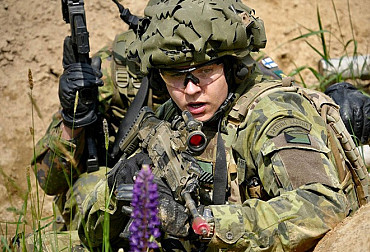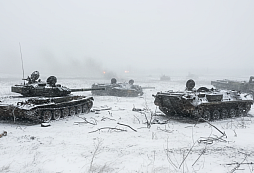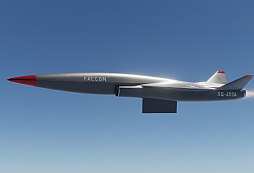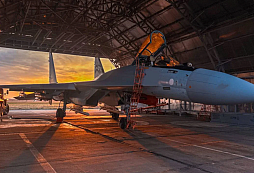Former Second in Command of the Israeli Air Force: Today 80-90 % of IDF flight hours are done by drones
We had a great opportunity to interview Major General (ret.) Hagi Topolanski, former second in command of the Israeli Air Force, air base commander, wing commander, squadron commander, fighter pilot, also flight school instructor, and the main subject of the interview was the Israeli Defense Force's experience with the Unmanned Aerial Vehicles. And we also touched the question of the F-35 5th generation stealth fighter introduced in the Israeli Air Force.
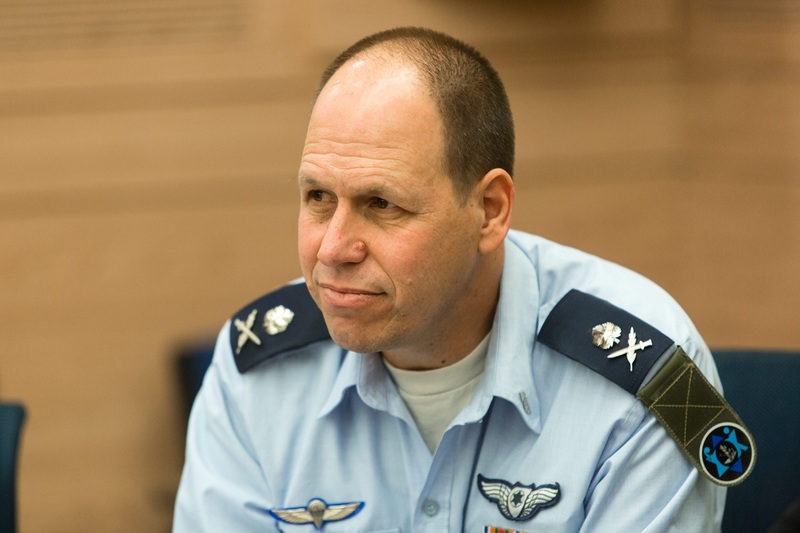 Picture: Major General Hagi Topolansky | IAF
Picture: Major General Hagi Topolansky | IAF
Major General Hagi Topolansky is behind the development of the Israeli Air Force drone branch, and he was involved in the integration of the Elbit Hermes 900 unmanned systems into IAF. The IDF's Ground Forces, at all tactical levels, benefit from support of both the so called "green" UAVs (platforms operated by the ground forces) and "blue" UAVs (platforms operated by the air force). Video footage and still images of whatever is happening on the other side of the hill, on the battlefield or around the corner and on the roofs of houses in urban combat scenarios, data transmitted in real time, on line, from the payload camera to the operator's display screen, then interpreted and disseminated for intelligence purposes, became indispensable and inseparable, essential parts of any Israeli operation. And the capabilities of modern UAVs are not limited to intelligence or reconnaissance. They can deliver decisive strikes with precision ammunition, and the use of loitering ammunition is now a worldwide trend. The interview came appropriately the day after the 50th anniversary of the formation of the first Israeli UAV squadron.
General, what planes did you fly when you served in the Air Force?
I used to fly F-16s and F-15s, both of them American planes. Israel is getting a support from the US. This support is to be used obviously for purchasing mainly American products, and we use it to buy American platforms such as fighters. This continues since the 1970's. In the 1960's we were using French planes such as the Mirages. From the 1970's we switched mainly for US planes.
Which continues today with the F-35s...
Yes, F-35s right now. We've already purchased two squadrons of these. And there are discussion on buying more.
How do you evaluate the F-35, do you believe it is a game changer?
The F-35 really is a new generation. It is like to go from a phone to smartphone, the same concept. Most of the people who comment on this stealth 5th generation plane, they will tell you especially about its radar cross section, but this is not the real story. The real story of the F-35 is its ability to connect all the data into one picture to be used with all your partners together. The aircraft is very powerful in that it can gather the data, read the intelligence and attack the threats by itself, without being threatened itself. It is a huge change for the air force.
There are talks currently in the Czech Republic on the future of our supersonic airforce. And the F-35s are being considered as one of the options. Expensive one of course...
Yes. On the other hand when you compare the now mass produced F-35 at a current price of about 100 million dollars, which is enormous, to let's say a good F-15, I don't think you can find one in a comparable standard at less than 100 million dollars a piece. Maybe you can get a F-16 at some 60 million dollars, but not with the same capabilities at all. If you are looking for a cost effective solution, with the mass production the F-35 will be, and by far, a better choice.
Our main subject for today is the UAVs and Israel's experience with their development and use. When did the IDF include the first drones in its armament and what purpose did they serve?
Actually it is a very good time to ask this question. Because on March 23 we celebrated 50th anniversary of the formation of the first drone squadron in Israel. So the Israeli Air Force is operating the UAVs for fifty years now. The main task, the main missions were imagery, reconnaissance, in threatened areas.
How have their capabilities evolved over time, and what types are used today and for what tasks?
The main tasks remain in the area of intelligence. But now all kinds of intelligence. It is day and night operations, using radars, imagery, signals intelligence (SIGINT), communications intelligence (COMINT), electronic intelligence (ELINT), electronic warfare. And other missions I cannot speak about.
On the types, there are many. In different sizes, purpose, with single capability, with many capabilities. Also their performance is evolving. There are types which can fly for a few hours, others that can be put in operation for a whole day, some of them even for more days. They go from small quadrocopters to platforms of weight of several tons. They are replacing the human capabilities more and more. Eventually, whatever we accomplish today with manned helicopters, fighters, even transportation, will be accomplished by the drones tomorrow.
How many drones of various types does the IDF have at its disposal, or what number relative to the strength of the armed forces and the situation can be described as desirable?
It is of course hard to tell, it depends on the needs, on the situation, on the size of the country, its context, and many other parameters. However, I believe that any modern air force should be able to field big numbers of UAVs today, even compared to helicopters or planes. That is what is happening in Israel. Obviously, when an air forces begins to use the UAVs, it should start with the small size drones. Learn the concept of operation. In Israel, it came around 2010 and it was a big change. Instead of the UAV being just a part of equipment used during operations, and in small numbers, it becomes to the be main tool. Today in Israel, 80-90% of the operation hours of Israeli Air Force are done by UAVs, and 85%of them are today realized by Hermes drones. This may answer your question.
Can you mention, at least in general terms, some operations in which IDF drones have been successfully deployed?
Too many of course. For example, during the Lebanon war in summer of 2006, all operations saw big numbers of UAVs, most of the intelligence came from the UAVs. They did operate on the other side of the border, over Lebanon or over Gaza, and over other places. And today there won't be any operation carried out by the IDF, in which the UAVs don't take main role. Today we do not send ground soldiers without being sure that the area is clear and safe. UAVs are involved in every kind of operation.
In the Czech Republic, it is sometimes argued that we do not need expensive ground armoured vehicles, that the future of the armed forces lies in technologies such as drones. But no system is self-sustaining, do you agree?
Yes and no. From one side I believe that the armed forces should use a combination of capabilities and tools according to the task. Not just one. On the other side I would say that there will enventually really less need of fighters, attack helicopters, armoured vehicles. The drones can do the same mission with little risk, they provide cost effective capabilities.
You mean the UAVs make the deployment of ground forces more efficient, thanks to the information they provide for example, so in the end not so many troops are needed.
For sure. And more than that. In Israel the UAVs operate both in the air and ground forces. Generally speaking the smaller drones are used by the Army, the larger types are operated by the Air Force. And I believe it can be the same for the Czech and other armed forces the same. Virtually any military unit can operate a drone to its benefits.
What advantages do UAVs offer compared to subsonic aircraft of similar purpose? And does it have any disadvantages at all?
The first of the advantages is the endurance, and the fact that there is no pilot, so there is no risk. Than there is the decision making proces. I am a fighter pilot. When I fly in my suit and maneuver with the g-power, etc., it can really be hard to take the right decision. But if you compare it to the UAV where the pilot is sitting in an office, behind his desk, with his computer and his mouse, he can take the decision together with his manager and the whole team. You can easily share the information with all the relevant partners. From an individual soldier on the battlefield to the president. Expose them to the same picture that the pilot sees.
There is a lot of advantages. However, the UAVs also have some disadvantages indeed. The biggest one is that you depend on communications. Without proper communications, the effectivness of any UAV is very small. Sure, there can be autonomous systems, etc, but you still need a communication, an uplink, downlink, in order to be able to exploit on the capability of the system.
Drones have been successfully deployed recently in Syria, Nagorno-Karabakh and are flying over Ukraine today. We are currently monitoring the performance of mainly Turkish TB2 Bayraktar over Ukraine. These are widespread in the world today - are they cost effective?
The TB2 is actually a kind of mimic of the the Israeli Elbit Hermes 450. We supplied the Turks with it many years ago, and they started to work on it, and they learned how to make it. TB2 certainly is a relevant piece of equipment. It always takes time to mature such a system. It's the engine, the communication system, the computer, every UAV is actually a system of systems. It is not just the platform. The platform is one thing. Than there are the sensors, you have the ground station. And it takes time to mature the system.
On the other hand, I would not buy from Turks for other reasons. Today in the world boycots or sanctions can easily be taken, concerning engines and other systems. So I would always buy equipment from Western countries. So that, in emergency, you can be sure to have all the needed capabilities and support.
The Czech Army has mainly American types RQ-11, Wasp III, Scan Eagle, but also Israeli Elbit Skylark miniature UAVs. What other Israeli types could our army possibly use?
I think that not only Isreali ones, and I think that you should use all existing kinds of UAVs in order to gain from their different capabilities. Like I said, for the ground forces the smaller drones, today in Israel there exists a quadrocopter which weigths 5-10 kg, there is the Skylark. There are other platforms of different weights. And your armed forces should consider using all of them. Including the loitering ammunition which is a trend all over the world.
Thank you for these answers, general. Have you had an opportunity to visit the Czech Republic?
Yes, I have been to Prague. You have a very beautiful capital. The people were very nice. It was during Christmas, so it was cold. I should certainly come again soon.
















